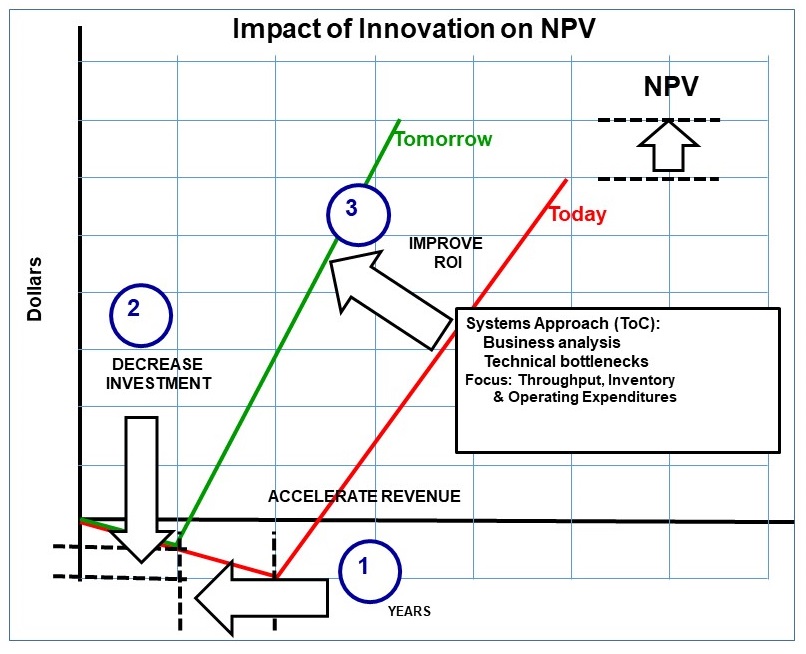MI-GPS
Business Analysis & Systems Approach for Mining Innovation & CommercializationCEMI’s Mining Innovation GPS (MI-GPS)
Mining is a system, not a collection of technologies. This is most obviously true in the processing plant where the entire process is an integrated system, but it less obvious in raw production and in tailings management. Improving these processes has to be approached systematically so that any new change allows the whole system to work better, safer, cheaper than before. Mining innovation is not about developing technical solutions; it is about implementing new ways of doing things that improve business results – profitability and productivity, as well as safety. New technological solutions become successful innovations only when they can make a significant impact on the business needs of the operation, as well as solving an operational problem. A good technical solution has limited value if it improves operating performance, or reduces cost, by only 1-2%, especially when there more critical and costly issues that need to be changed. An innovation that requires a large capital investment is of little value to a mine that has only a few more years of ore production left; there is too little time left to recoup the cost of the investment. Mining innovation is more about business solutions than technological solutions.
Agreeing on the problem and finding possible solutions is only part of the innovation process. The first step is to identify and prioritize the issues that have the biggest impact on the business, then focus on solving these. Even then, just assembling a list of possible technological options is not the second step; not all solutions are technological – organizational solutions can also solve business problems too, often more cheaply than anything else. A list of technological options is like having a roadmap; it cannot help if the destination is unknown – and in innovation the solution or destination is not always obvious. What is always known, is that we have to leave where we are, change what we are doing, because it is no longer sufficiently safe or profitable. We have to go in a new direction, and some options are better than others. The choice of direction has to be driven by the impact on the business, in order to avoid implementing changes that are beneficial but have little impact on the profitability of the business.
CEMI’s MI-GPS approach
CEMI recognizes that all operations have constraints that mean they are not completely free to make just any choice of destination – it has to fit within the commercial and technical limitations that confront them, and the route has to be passable. We use the theory of Constraints (ToC) to decide which to tackle first, then address the technical bottlenecks, beginning with the one with the biggest impact on the business – not the easiest or the most interesting problem to solve.

Deep Metal Mining
Time is the forgotten commodity in metal mining today; the lean production techniques implemented during Industry 3.0, and which make Industry 4.0 possible, are virtually unknown in the mining industry. The focus has been on safety, cost reduction and increasing scale; lean manufacturing is now critical. It is important to distinguish between incremental and large-scale change; external organizations cannot address the former, only internal departments can affect incremental improvements. Deployment of operating-cost improvements and capital-cost innovations both require investment, but the latter are best suited to new mines with a long mine-life to recoup the investment, while older mines must focus on operating-cost innovations with shorter payback periods.
Matching Constraints and Characteristics.
Here are some system constraints in deep underground mines along with the desirable characteristics that can address each constraint.
SYSTEM CONSTRAINTS | DESIRABLE SYSTEM CHARACTERISTICS | |
Highly changeable geotechnical stability. | Permanent access to assess and/or correct. | |
Highly changeable operating conditions. | Permanent access to assess and/or correct. | |
High ventilation cost. | Electric systems & reduce total energy demand. | |
Extreme heat conditions. | Active cooling, targeting critical system components. | |
High-capacity Production. | Continuous ore flow, not batch transportation. | |
High-value Production. | Upgrading – ore sorting and rock recycling. | |
Shaft Hoisting Capacity. | Increase vertical transport capacity. | |
Zero Harm Requirement. | Provide protection & remove from hazard. | |
High Labour Cost. | Automated or autonomous equipment. | |
Automated & Autonomous Equipment. | High reliability and modular replacements. | |
Innovation Integration Approach. | Gradual, replacing one at a time, reversable. |
Examples
In the case of deep underground mining operations, the speed at which new orebodies are accessed is critical – it has a significant impact on NPV and if the project NPV is too low, other projects will be more attractive and capital will be deployed elsewhere. In deep mines, geotechnical instability caused by high rock stresses is an unavoidable constraint – and the best approach to highly changeable conditions is relatively small, maneuverable equipment, as distinct from large, massive equipment. In deep mines ambient heat has to be controlled to provide tolerable conditions. Low-cost cooling, targeting only critical components, is essential.

Deep mines have higher logistical costs that must be offset by higher revenue generation achieved by higher throughput and higher value. Continuous and autonomous ore flow, ore sorting with waste diversion, and fines recovery and dense medium hoisting can all contribute to greater value generation. Autonomous operating systems require many fewer few people underground, dealing with abnormal situations and re-supplying the autonomous equipment. In ultra-deep mines, people will wear suits providing comprehensive PPE (CPPE); providing protection against all air-borne hazards such as heat, humidity and dust as well as physical hazards, plus hands-free voice-video-data communications.
Finally, the greatest delay in bringing mines into production is obtaining permits and approval for new tailings management systems. Implementing new approaches that prevent both the catastrophic failure of tailings storage facilities and the gradual escape of fugitive toxic dust is essential. Mines that can prove they can implement a progressive, self-sustaining mine closure systems that eliminate all negative impacts on human health and local ecologies in the long term, can restore the industry’s credibility, make tailings facilities easier to approve and so accelerate the opening of new mines.
CEMI has supported its partners to develop technologies that achieve all of these objectives.
